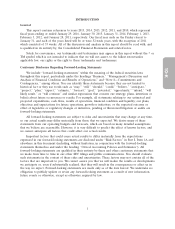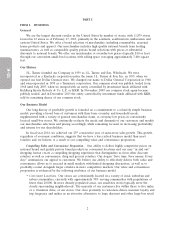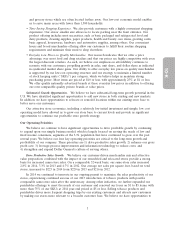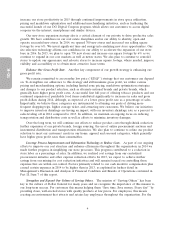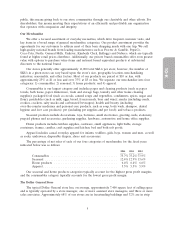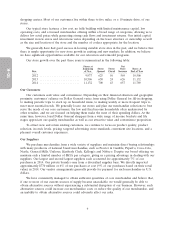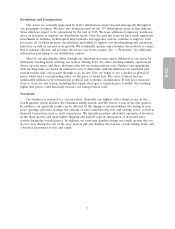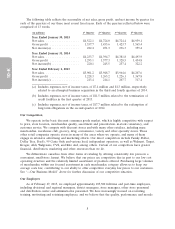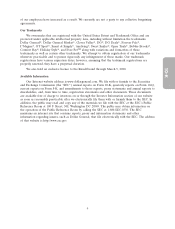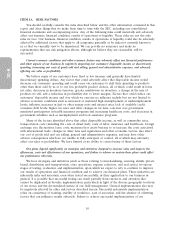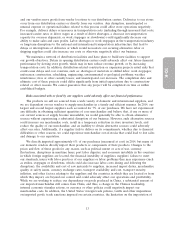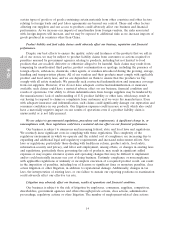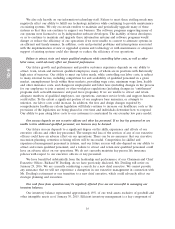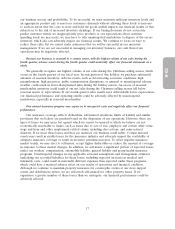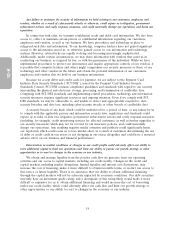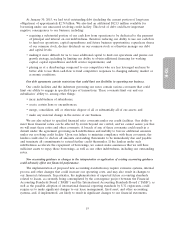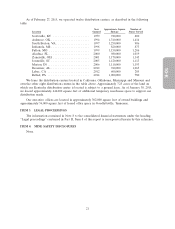Dollar General 2014 Annual Report Download - page 85
Download and view the complete annual report
Please find page 85 of the 2014 Dollar General annual report below. You can navigate through the pages in the report by either clicking on the pages listed below, or by using the keyword search tool below to find specific information within the annual report.
10-K
initiatives or the cost of these initiatives exceeding management’s estimates could adversely affect our
business, results of operations and financial condition.
The success of our merchandising initiatives, particularly those with respect to non-consumable
merchandise and store-specific products and allocations, depends in part upon our ability to predict
consistently and successfully the products that our customers will demand and to identify and timely
respond to evolving trends in demographics and consumer preferences, expectations and needs. If we
are unable to select products that are attractive to customers, to obtain such products at costs that
allow us to sell them at an acceptable profit, or to effectively market such products, our sales, market
share and profitability could be adversely affected. If our merchandising efforts in the non-consumables
area or the higher margin areas within consumables are unsuccessful, we could be further adversely
affected by our inability to offset the lower margins associated with our consumables business. Further,
our merchandising efforts in the consumables area, including tobacco products, may not generate the
net sales growth and increase customer traffic to the levels needed to offset the lower margins
generated by sales of consumables and maintain our targeted gross profit margins.
If we cannot open, relocate or remodel stores profitably and on schedule, our planned future growth will
be impeded, which would adversely affect sales.
Our ability to open, relocate and remodel profitable stores is a key component of our planned
future growth. Our ability to timely open stores and to expand into additional market areas depends in
part on the following factors: the availability of attractive store locations; the absence of entitlement
process or occupancy delays; the ability to negotiate acceptable lease and development terms; the
ability to hire and train new personnel, especially store managers, in a cost effective manner; the ability
to identify customer demand in different geographic areas; general economic conditions; and the
availability of capital funding for expansion. Many of these factors also affect our ability to successfully
relocate stores, and many of them are beyond our control.
Delays or failures in opening new stores or completing relocations or remodels, or achieving lower
than expected sales in new stores, could materially adversely affect our growth and/or profitability. We
also may not anticipate all of the challenges imposed by the expansion of our operations and, as a
result, may not meet our targets for opening new stores, remodeling or relocating stores or expanding
profitably.
Some new stores may be located in areas where we have little or no meaningful experience or
brand recognition. Those areas may have different competitive and market conditions, consumer tastes
and discretionary spending patterns than our existing markets, as well as higher cost of entry, which
may cause our new stores to be initially less successful than stores in our existing markets.
Many new stores will be located in areas where we have existing stores. Although we have
experience in these areas, increasing the number of locations in these markets may result in inadvertent
oversaturation and temporarily or permanently divert customers and sales from our existing stores,
thereby adversely affecting our overall financial performance.
Our profitability may be negatively affected by inventory shrinkage.
We are subject to the risk of inventory loss and theft. We experience significant inventory
shrinkage and cannot be sure that incidences of inventory loss and theft will decrease in the future or
that the measures we are taking will effectively reduce the problem of inventory shrinkage. Although
some level of inventory shrinkage is an unavoidable cost of doing business, if we were to experience
higher rates of inventory shrinkage or incur increased security or other costs to combat inventory theft,
our results of operations and financial condition could be affected adversely.
11


